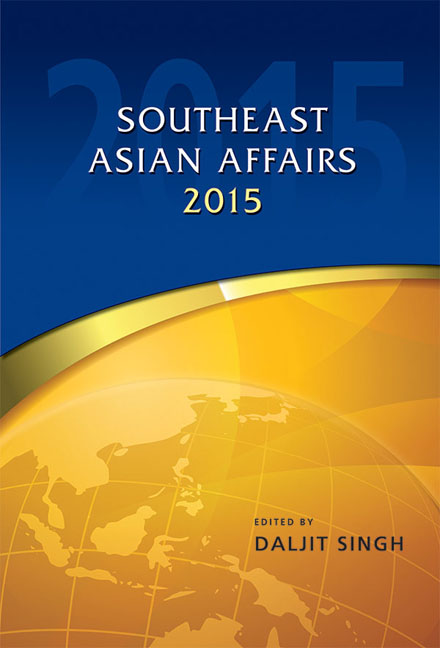Book contents
- Frontmatter
- Contents
- Foreword
- Introduction
- Acknowledgements
- THE REGION
- BRUNEI DARUSSALAM
- CAMBODIA
- INDONESIA
- LAOS
- MALAYSIA
- Malaysia in 2014: A Year of Political and Social Ferment
- The Hudud Controversy in Malaysia: Religious Probity or Political Expediency?
- MYANMAR
- THE PHILIPPINES
- SINGAPORE
- THAILAND
- TIMOR-LESTE
- VIETNAM
Malaysia in 2014: A Year of Political and Social Ferment
from MALAYSIA
Published online by Cambridge University Press: 19 May 2017
- Frontmatter
- Contents
- Foreword
- Introduction
- Acknowledgements
- THE REGION
- BRUNEI DARUSSALAM
- CAMBODIA
- INDONESIA
- LAOS
- MALAYSIA
- Malaysia in 2014: A Year of Political and Social Ferment
- The Hudud Controversy in Malaysia: Religious Probity or Political Expediency?
- MYANMAR
- THE PHILIPPINES
- SINGAPORE
- THAILAND
- TIMOR-LESTE
- VIETNAM
Summary
Introduction
The year 2014 saw an intense conflict between liberalism and narrow conservatism in Malaysia. The push for democracy and inclusive policies by the opposition and civil groups opened up a call from the right-wing Malays to “reclaim” their special rights and position as the “indigenous” people of the land. The right-wing Malays even raised the ghost of May 13, the bloody racial riot that brought at least 200 civilian deaths with ethnic Chinese making up the biggest number. The Malay-dominated ruling government remained tightlipped over the right-wing groups’ antics, hence implying its support for them which helped to perpetuate the spread of racial politics. The conflict became more complex with the internal schisms in the two main parties, Barisan Nasional (National Front or BN), and opposition coalition, Pakatan Rakyat (People's Alliance or PR) which led to further division and discord among the general public.
The political and social ferment continued to persist despite a long list of tragedies that hit Malaysia in 2014. From the mysterious disappearance of Malaysia Airlines MH370 on 8 March to MH17 that was shot out of the sky on 17 July to the tragic crash of Air Asia Indonesian flight QZ8501 on 28 December, the majority of Malaysians were divided along party lines over the way the authorities handled these calamities. As the year was drawing to a close, Malaysia was hit with the worst floods in three decades. More than 150,000 had to be evacuated with infrastructure losses amounting to RM2 billion (US$0.58 billion). The unprecedented disaster, however, failed to heal the political divisions.
On the economic front, Malaysia continued to record higher growth even though it faced multiple challenges in keeping its economy competitive and strong in its push to be a developed economy by 2020. Global forces such as the declining oil prices along with its own archaic economic policies had impeded Malaysia's potential to grow and expand. One of the indications of a troubling domestic economy was the steep increase in household debt over the years, turning Malaysia into a country with the highest household debt in Southeast Asia. Some analysts even argued that Malaysia was going through the middle income trap where it would be facing great difficulty in leaping forward to become a developed nation.
- Type
- Chapter
- Information
- Southeast Asian Affairs 2015 , pp. 189 - 204Publisher: ISEAS–Yusof Ishak InstitutePrint publication year: 2015

